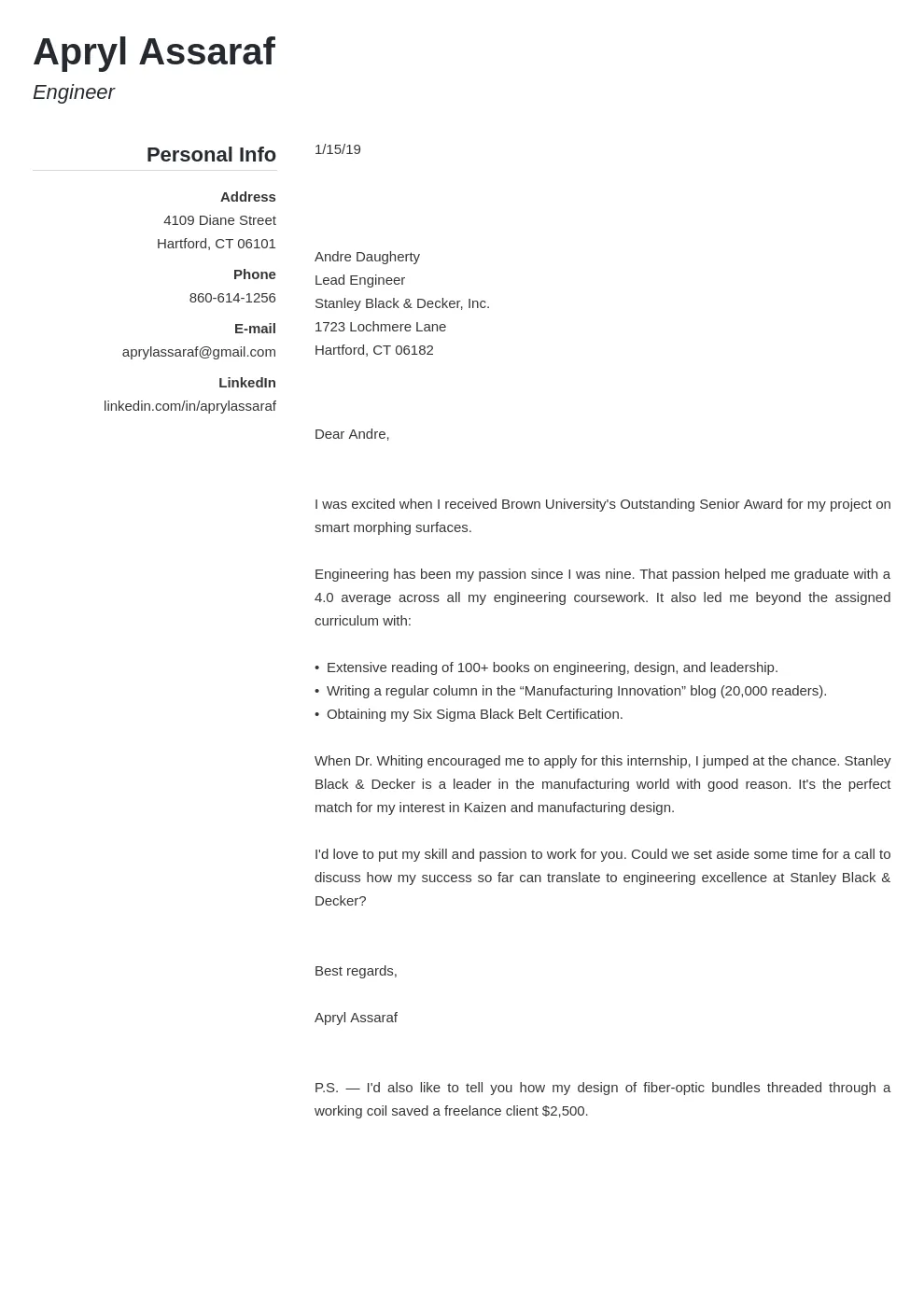What is an Internship Cover Letter
An internship cover letter is a crucial document that accompanies your resume when applying for an internship. It serves as your introduction to the hiring manager, allowing you to showcase your personality, skills, and enthusiasm for the specific internship opportunity. Unlike a resume, which provides a factual overview of your experience, a cover letter allows you to tell a story, explaining why you are a good fit for the role and the company. It’s your chance to make a strong first impression and distinguish yourself from other applicants. The goal is to compel the reader to want to learn more about you and invite you for an interview.
Key Elements of a Strong Cover Letter
To create a standout cover letter, several key elements must be included. These elements work together to present a cohesive and compelling case for your candidacy. By carefully crafting each section, you can significantly increase your chances of getting noticed by potential employers. Ensure each part of the cover letter is tailored to the specific internship and the company’s needs to maximize its effectiveness. Focusing on these points will help your application stand out.
Header Information
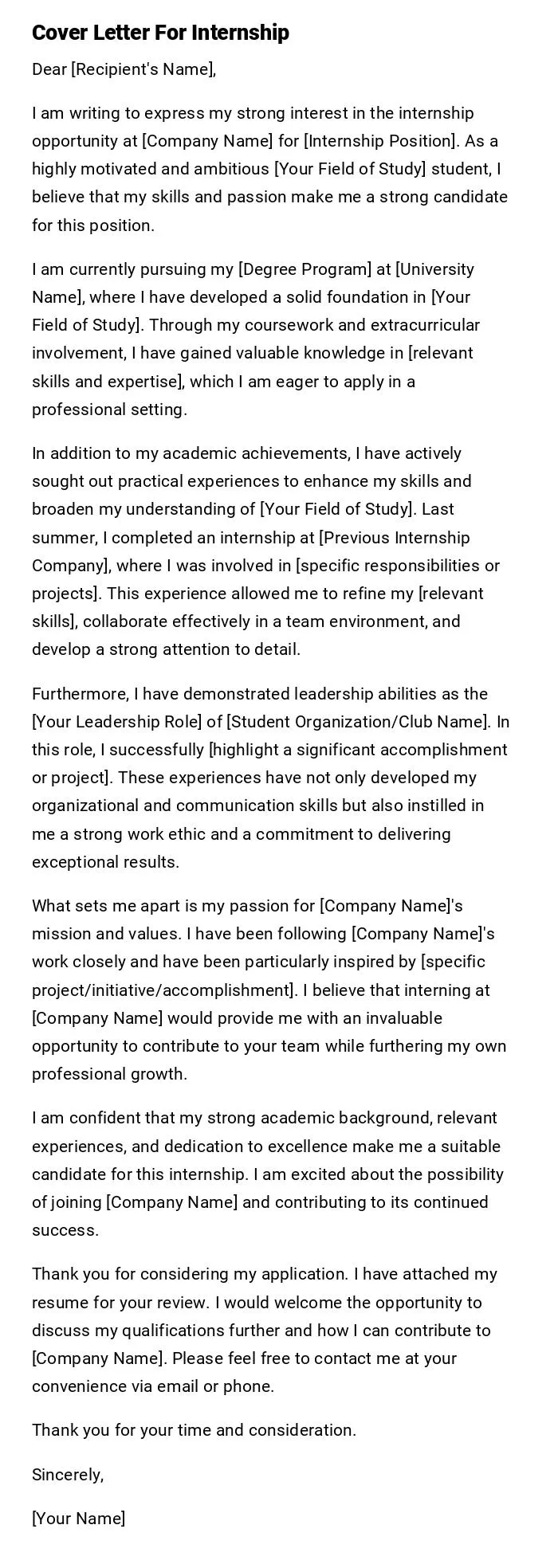
Your header should contain your full name, address, phone number, and email address. This allows the hiring manager to quickly identify your contact information. Make sure that the format is neat and easy to read. Consistency in formatting is key. This section is a critical first impression and must be error-free.
Contact Information
Include the current date directly below your header. Following the date, provide the hiring manager’s name, their title, and the company’s name and address. If you cannot find the hiring manager’s name, research the company website or LinkedIn. Addressing the letter to a specific person shows you have taken the time to prepare. This is where you show attention to detail.
Salutation
Use a professional salutation, such as “Dear Mr./Ms./Mx. [Last Name]”. If you do not know the hiring manager’s name, use “Dear Hiring Manager” or “Dear [Department Name] Team.” Avoid generic salutations like “To Whom It May Concern.” Using a specific name, when possible, personalizes the letter and indicates you have done your research. Getting the salutation right helps create a positive first impression.
Body Paragraph 1 Why You’re Interested
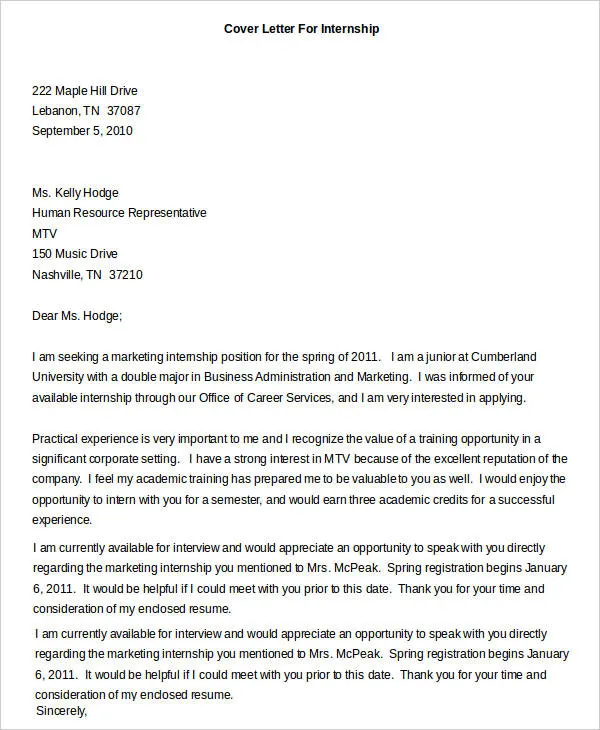
Start your cover letter by clearly stating the position you are applying for and where you found the job posting. Briefly explain why you are interested in the internship and the company. Show your enthusiasm and highlight what attracted you to the opportunity. Demonstrate that you have researched the company and understand its mission or values. This initial paragraph sets the tone and creates a strong starting point, drawing the reader in. Use this space to make an immediate impact.
Highlight Your Skills and Experience
In the following paragraphs, highlight the skills and experience relevant to the internship. Don’t just list your skills; provide specific examples of how you have used those skills to achieve results. Use the job description as a guide, and tailor your letter to match the requirements. This section should demonstrate that you have the qualifications needed to succeed in the role. Make your skills come alive with real-world examples. By doing this, you demonstrate why you are the ideal candidate.
Tailor to the Internship
Each cover letter should be tailored to the specific internship you are applying for. Research the company and understand the role’s requirements. Use the job description to identify the key skills and qualifications they are seeking. Then, customize your letter to emphasize your relevant experience and how you meet those needs. A generic cover letter will not impress a potential employer. Customization shows that you are genuinely interested and have taken the time to understand the opportunity.
Body Paragraph 2 Showcase Your Achievements
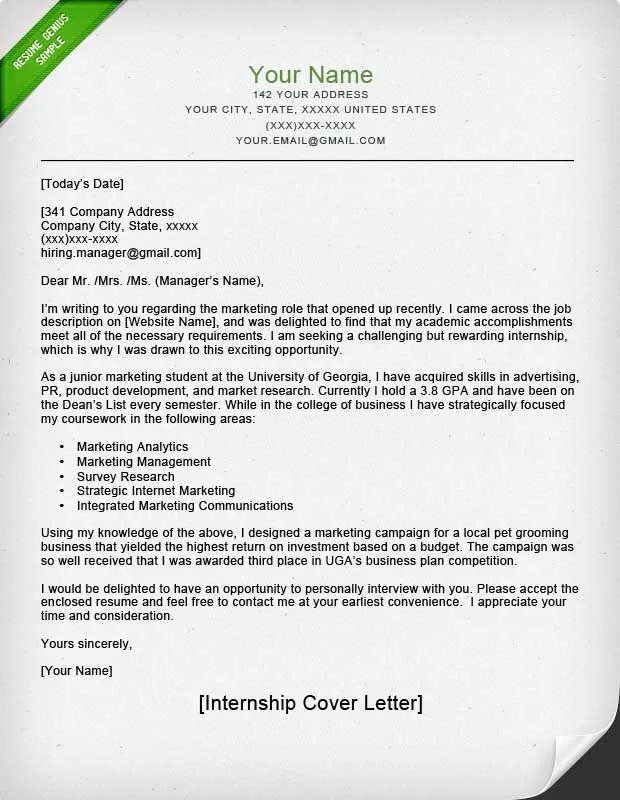
Focus on your achievements, not just your responsibilities. Provide specific examples of what you have accomplished in past roles or projects. Quantify your achievements whenever possible. Use numbers and data to demonstrate the impact of your work. This section of your cover letter should provide concrete evidence of your capabilities. By providing quantifiable results, you give the hiring manager clear reasons to consider you a top candidate. Highlight the impact you made in previous experiences.
Quantify Your Accomplishments
Whenever possible, quantify your accomplishments. Instead of saying “Improved customer satisfaction,” say “Increased customer satisfaction by 15%.” Use data to back up your claims and provide concrete evidence of your achievements. Numbers and data add credibility and make your accomplishments more impactful. Quantifiable results make it easier for the hiring manager to understand your impact and value. This approach makes you stand out from other applicants.
Use Action Verbs
Start your sentences with strong action verbs. Action verbs make your accomplishments sound more dynamic and engaging. Instead of saying “Responsible for managing social media,” say “Managed social media campaigns, resulting in a 20% increase in followers.” Choose verbs that accurately describe your actions and results. Action verbs make your cover letter more compelling and give the reader a clearer picture of your capabilities. A powerful use of action verbs can quickly capture attention.
Body Paragraph 3 Express Enthusiasm
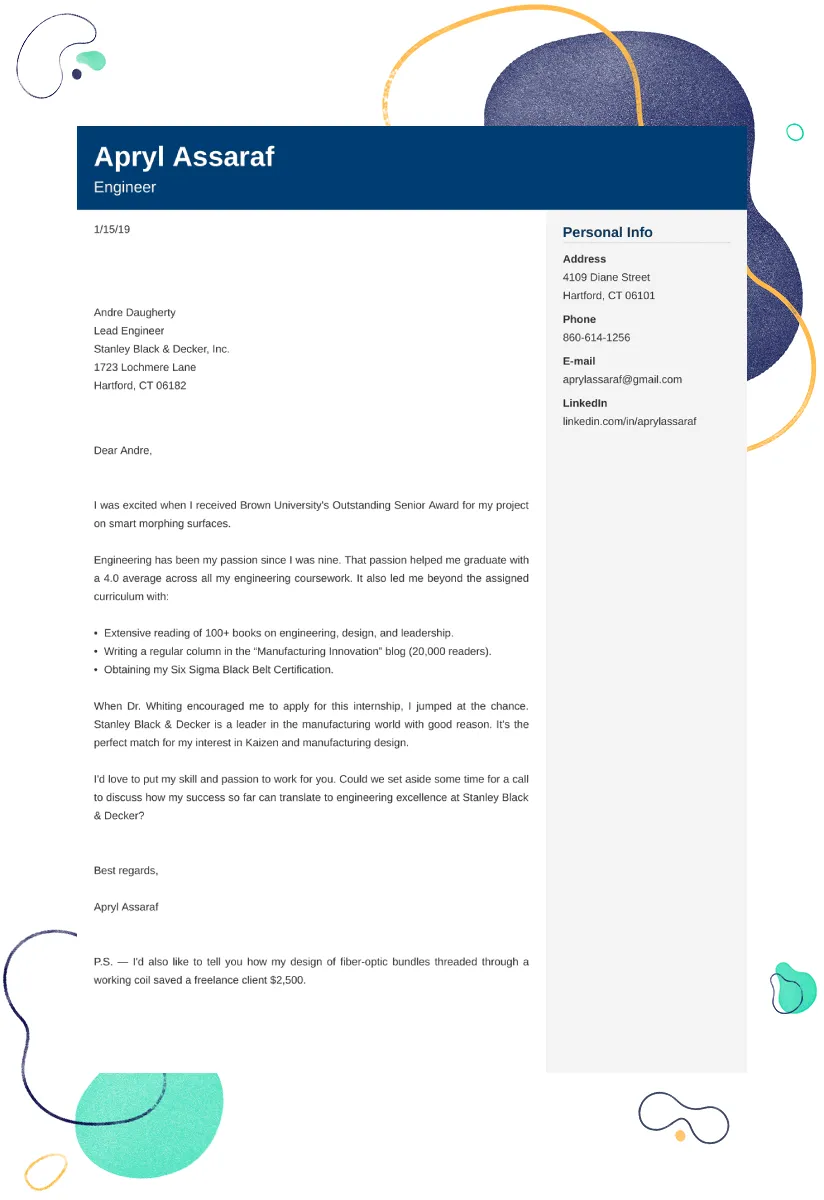
Express your enthusiasm for the internship and the company. Explain why you are excited about the opportunity and what you hope to achieve. Demonstrate that you are a good fit for the company culture and that you are eager to contribute. Show that you have researched the company and understand its mission or values. Sincerity goes a long way. Expressing genuine interest will help you make a positive impression on the hiring manager and show your passion for the role.
Mention Company Values
Refer to the company’s values and explain how your values align with theirs. Research the company’s website, social media, and press releases to understand what they stand for. Then, in your cover letter, explain how your skills and experiences reflect these values. This helps you show that you are a good cultural fit. Mentioning company values will make you more attractive to the employer. This shows you’ve invested time in learning about the company.
Explain How You Can Contribute
Clearly state how you can contribute to the company. Briefly explain the specific skills and experiences that will enable you to succeed in the internship. This demonstrates that you understand the role’s requirements and are prepared to make an impact. Give the hiring manager a clear idea of the value you will bring to their team. Show your understanding of the internship responsibilities.
Closing Paragraph Call to Action
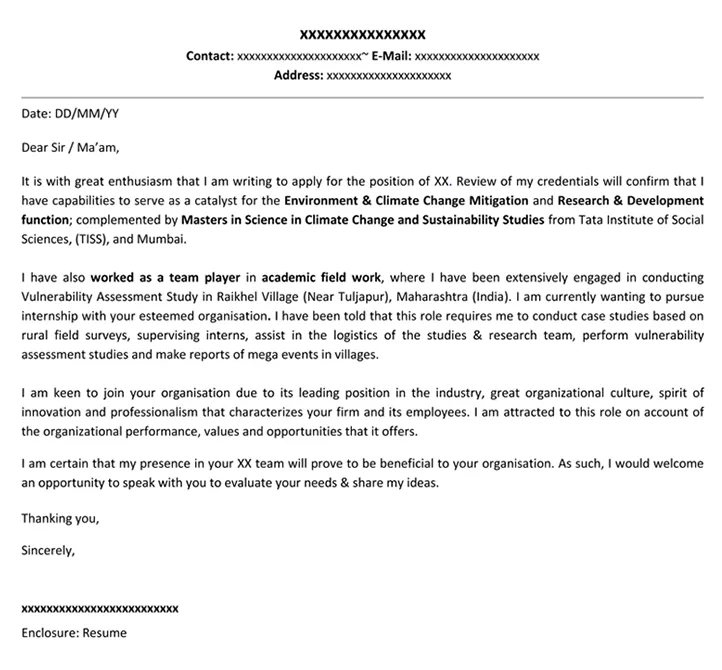
In your closing paragraph, reiterate your interest in the internship and the company. Express your enthusiasm and make a clear call to action. State that you are looking forward to the opportunity to discuss your qualifications further and that you are available for an interview. Make it easy for the hiring manager to contact you. A strong closing paragraph motivates the reader to take the next step.
Express Gratitude
Thank the hiring manager for their time and consideration. Show your appreciation for the opportunity to be considered. Expressing gratitude leaves a positive impression and demonstrates your professionalism. A simple thank you can have a significant impact on the overall tone of your letter. It shows courtesy and respect for the hiring manager.
Professional Closing
Use a professional closing, such as “Sincerely,” “Best regards,” or “Thank you.” Avoid casual closings like “Best” or “See you soon.” Sign your name above your typed name. A professional closing sets the right tone and helps end your letter on a positive note. Consistency throughout the letter is key to making a good impression.
Formatting Tips
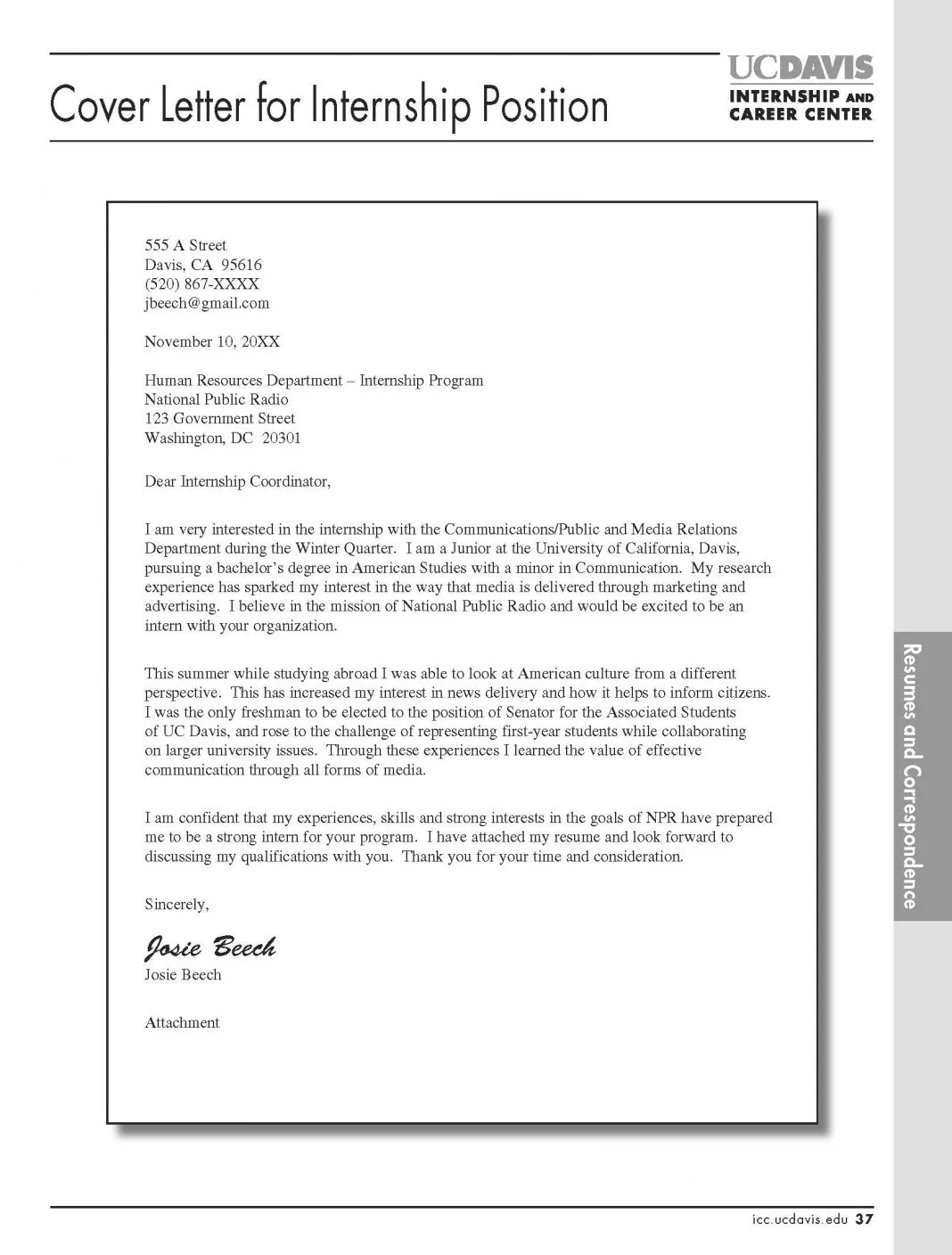
Proper formatting is essential for creating a polished and professional cover letter. Formatting makes your letter easier to read and presents you in the best possible light. Pay attention to font, spacing, and overall layout to make a strong impression. A well-formatted letter shows that you care about the details. Formatting enhances readability and professionalism. It makes your message more accessible.
Font and Style
Choose a professional and readable font, such as Times New Roman, Arial, or Calibri. Use a font size between 10 and 12 points. Ensure your text is easy on the eyes and avoids a cluttered appearance. Use consistent formatting throughout your document to maintain a clean and organized look. A clear font choice and layout contribute to the overall professionalism. Consistency in font and style is important for a professional presentation. Choose a classic font for a clean look.
Proofreading
Thoroughly proofread your cover letter for any grammatical errors, spelling mistakes, and typos. These errors can damage your credibility. Check for correct sentence structure and proper punctuation. Ask a friend or family member to review your letter as a second set of eyes. Proofreading is a critical step in the application process. A flawless cover letter demonstrates attention to detail and professionalism. Proofread carefully before submitting your letter.
Cover Letter Samples
Review cover letter samples to get an idea of how to structure and format your own letter. Many resources online offer examples tailored to different industries and roles. Use these samples as a guide, but always customize your letter to match the specific internship and your own experiences. The key is to adapt the samples to best represent your unique qualifications. Cover letter samples can provide a good starting point. Samples provide a valuable template and can assist you in developing your cover letter.
Sample 1 Engineering Internship
Include examples specific to engineering principles, projects, and software. Show how your skills contribute to engineering challenges, and how your past experiences have provided you with expertise. Make sure to present your technical skills, such as programming, design, and analysis skills in a clear and concise format. Focus on practical experiences like designing and building projects.
Sample 2 Marketing Internship
Emphasize your marketing skills, such as market research, social media management, and content creation. Highlight your ability to analyze data, create effective campaigns, and drive customer engagement. Provide examples of marketing projects you have been involved with, and what you were able to accomplish. Show your knowledge of marketing strategies, and demonstrate how you align your experience with the marketing team objectives.
Sample 3 Finance Internship
Demonstrate your financial analysis, accounting, and investment skills. Showcase your familiarity with financial statements, data analysis, and market research. Highlight your ability to work with financial data and your attention to detail. Focus on experience and coursework that are relevant to the finance world. Present your knowledge of financial concepts and your abilities to perform financial tasks. Show your experience with budgeting and forecasting.
Sample 4 Software Development Internship
Highlight your programming skills, your knowledge of coding languages, and experience with software development. Showcase the projects you have contributed to or led, and the results achieved. Explain your technical skills and demonstrate your ability to create and design software applications. Include practical coding experience to demonstrate expertise. Present projects and past experiences to make yourself stand out. Showcase expertise in front-end or back-end development.
Sample 5 Graphic Design Internship
Showcase your design skills and the projects you have created. Include your portfolio to demonstrate your abilities. Describe your experience with design software and explain the value your projects can bring. Highlight your creativity and your ability to translate ideas into effective visual communication. Describe projects you created to convey your abilities. Present your design process and experience.
Final Tips for Success
To increase your chances of success, keep these final tips in mind. Tailor your letter to the specific requirements of each internship, and always proofread carefully. A well-crafted cover letter can be the difference between landing an interview and getting passed over. Focusing on customization and attention to detail will give your application a significant advantage. Pay attention to the details in the application process.
Customize Each Letter
Do not use a generic cover letter. Take the time to tailor each letter to the specific internship and company you are applying to. Research the company, understand their needs, and customize your letter to highlight the skills and experiences most relevant to the role. This demonstrates your genuine interest and commitment. Customization enhances your application. Tailoring your letter to each role increases your chances.
Follow Submission Guidelines
Carefully review and follow the submission guidelines provided by the company. Ensure you submit your cover letter and resume in the required format and through the specified channels. Failing to follow these instructions can result in your application being overlooked. Adhering to the submission instructions is a display of professionalism. Following the guidelines shows you value the company’s needs.
Review and Revise
Before submitting your cover letter, review and revise it multiple times. Check for any errors in grammar, spelling, and formatting. Ask a friend, family member, or career advisor to review your letter for feedback. Ensure your letter is clear, concise, and effectively communicates your qualifications and enthusiasm. Careful review and revision make your application much more effective. Revise your cover letter to optimize the final version.
